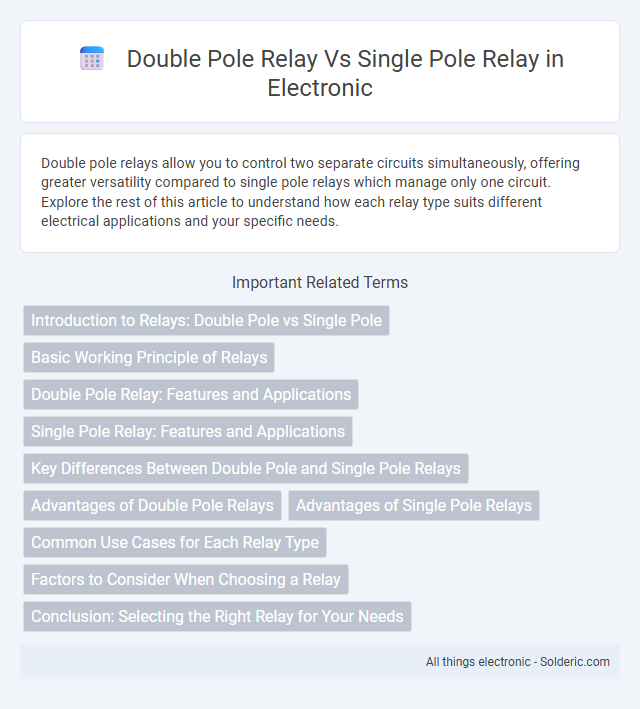Double pole relays allow you to control two separate circuits simultaneously, offering greater versatility compared to single pole relays which manage only one circuit. Explore the rest of this article to understand how each relay type suits different electrical applications and your specific needs.
Comparison Table
| Feature | Double Pole Relay (DPDT) | Single Pole Relay (SPST/SPDT) |
|---|---|---|
| Number of Poles | Two poles (two separate circuits) | One pole (one circuit) |
| Contact Configuration | Double Pole Double Throw (DPDT) | Single Pole Single Throw (SPST) or Single Pole Double Throw (SPDT) |
| Switching Capability | Can switch two independent circuits simultaneously | Switches one circuit |
| Applications | Reversing motor direction, control of two circuits | Basic ON/OFF control, switching single circuits |
| Size | Larger due to two poles | Smaller and compact |
| Cost | Higher cost | Lower cost |
Introduction to Relays: Double Pole vs Single Pole
Double pole relays feature two sets of contacts that operate simultaneously, allowing control of two separate circuits or providing greater switching capacity compared to single pole relays, which have a single set of contacts for one circuit. Single pole relays are typically used in simpler applications requiring control of a single electrical path, while double pole relays enable more complex circuit management, such as switching both live and neutral lines. The choice between double pole and single pole relays depends on the specific requirements for circuit separation, load handling, and safety in electrical and automation systems.
Basic Working Principle of Relays
A Double Pole Relay operates with two separate circuits controlled by a single coil, enabling simultaneous switching of two independent circuits, whereas a Single Pole Relay switches only one circuit using a single set of contacts. Both types function by energizing an electromagnet coil, which mechanically moves the contacts to open or close electrical connections, facilitating the control of high-current loads with low-current signals. The fundamental working principle involves electromagnetic induction that actuates the relay contacts, ensuring electrical isolation between control and load circuits.
Double Pole Relay: Features and Applications
Double Pole Relays feature two separate sets of contacts that can control two independent circuits simultaneously, providing enhanced versatility and reliability in electrical systems. These relays are commonly used in applications requiring isolation of different electrical loads or where switching of both the live and neutral lines is necessary for safety, such as in HVAC systems, industrial machinery, and multi-phase motor controls. Their ability to handle higher current ratings and offer improved circuit protection makes them ideal for complex automation and power management solutions.
Single Pole Relay: Features and Applications
Single pole relays feature one set of contacts, providing simple on/off control in electrical circuits, ideal for switching low to moderate loads. These relays are commonly used in home automation, automotive electronics, and basic industrial equipment due to their cost-effectiveness and reliability. Their compact design ensures seamless integration into control panels and circuit boards where straightforward switching is required.
Key Differences Between Double Pole and Single Pole Relays
Double pole relays control two separate circuits simultaneously with two sets of contacts, providing enhanced functionality compared to single pole relays, which operate only one circuit with a single set of contacts. Double pole relays are ideal for applications requiring isolation of two circuits or control of both live and neutral lines, whereas single pole relays suffice for simpler on/off control tasks. The choice between double pole and single pole relays depends on the complexity of the electrical system and the need for circuit isolation or simultaneous switching.
Advantages of Double Pole Relays
Double pole relays offer enhanced control by independently switching two separate circuits simultaneously, increasing system reliability and safety. They provide greater versatility in complex electrical applications, allowing for efficient management of multi-phase loads or dual voltage systems. This dual functionality reduces wiring complexity and potential failure points compared to single pole relays.
Advantages of Single Pole Relays
Single pole relays offer advantages in simplicity and cost-effectiveness, making them ideal for basic switching applications with lower complexity. They require fewer internal components, reducing space requirements and enhancing reliability in straightforward electrical circuits. Single pole relays are often preferred in automotive, industrial, and home automation systems where efficient and compact design is critical.
Common Use Cases for Each Relay Type
Double pole relays are commonly used in applications requiring simultaneous switching of two independent circuits, such as in industrial automation for controlling both power and signaling lines. Single pole relays, on the other hand, are ideal for simpler tasks like switching a single circuit in home automation systems or automotive electrical control. Your choice depends on whether you need to control multiple circuits simultaneously or just a single one.
Factors to Consider When Choosing a Relay
When choosing between a double pole relay and a single pole relay, consider the number of circuits you need to control simultaneously, as double pole relays can switch two independent circuits while single pole relays handle only one. Voltage and current ratings are critical; ensure the relay matches your system's electrical load to avoid malfunction or damage. Your specific application's complexity and space constraints also influence the decision, with double pole relays offering more functionality but requiring more space.
Conclusion: Selecting the Right Relay for Your Needs
Double pole relays provide the advantage of controlling two separate circuits simultaneously, ideal for applications requiring independent switching paths, while single pole relays are simpler and cost-effective for controlling a single circuit. Your choice depends on the complexity and safety requirements of your electrical system, with double pole relays offering enhanced versatility and isolation. Evaluate your current project demands carefully to ensure selecting the relay type that optimizes performance and reliability.
Double Pole Relay vs Single Pole Relay Infographic

 solderic.com
solderic.com